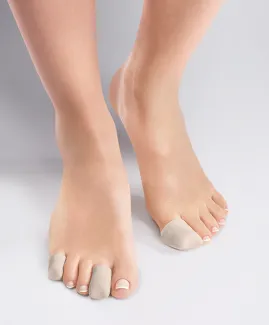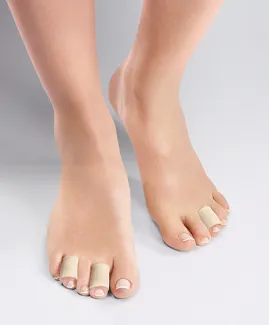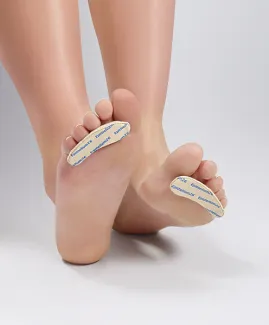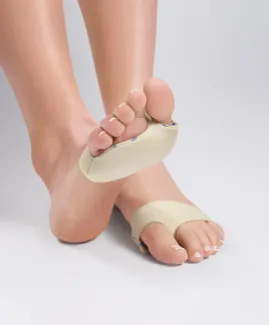What is a corn vs a callus? Do they have the same symptoms and causes? Indeed, there is confusion between both foot problems. However, they are different and may require specific treatments.
With EPITACT®, discover the similarities and differences between corns and calluses. Learn about how to identify them easily.
Corn vs callus: what are they exactly?
A corn or callus is a skin lesion called “callosity”. Both are thick and rough areas of skin named hyperkeratosis.
There is one single type of callus but two categories of corns:
- hard corns commonly sit on the top or tip of the toe, sometimes on the bottom of the foot.
- soft corns form between two toes.
Another difference between a corn and a callus is that there are several types of corns:
- vascular corn (presence of blood vessels),
- neurovascular corn (compression of the nerve ending),
- fibrous corns (long-standing corn that begins to attach to tissues),
- seed corns (collection of small corns).
Differences between corns and calluses: their location
Corns or calluses form on overpressure areas on a bony prominence, usually a joint. They can appear on the hands but they are much more frequent on the feet because the loads and pressure are higher.
The corn often sits on the toes (on the top, on the end or between). As for it, the callus frequently appears on the ball of the foot.
Also, a corn or callus is usually one single lesion, on both feet or not. However, a soft corn between two toes is often double: one on each toe.
What does a corn or callus look and feel like?
The first difference between a corn and a callus is that the corn is better delimited, smaller, and has a hard cone-shaped core made of keratin that penetrates the deep layers of the skin.
Because a soft corn is subject to humidity between two toes, it is soft and spongy. A callus, vs a corn, has less delimited borders, is wider and only affects the superficial layers of the skin.
Moreover, corns and calluses are distinguished by their colour: black centre with whitish edges for the corn vs yellowish colour for the callus. For soft corns specifically, the whitish edges can be surrounded by red, which is a sign of inflammation.
At last, a corn is painful whereas a callus is painless most of the time.
Differences between a corn and a callus: causes and risk factors
A corn or a callus develops after excessive and repeated pressure over a small skin area of the foot. Continuous rubbing against a rigid surface can also contribute to their onset. Also, corns and calluses are more frequent with ageing, especially in women.
So, both lesions have similar causes:
- ill-fitting shoes (high heeled shoes or shoes with a small toe box are considered poorly fitting shoes),
- excess weight,
- particular foot shapes and deformities that change the distribution of loads to the forefoot (e.g.: hallux valgus, hammer or claw toes, fallen or high arches),
- type of sports activities.
Another major difference between corns and calluses is that a callus is often caused by the atrophy of the plantar fat pad. This thick fatty tissue covers the bottom of the foot and provides shock absorption while walking or standing. Over the years, this layer tends to become thinner and pressure under the foot increases, which contributes to forming calluses.
Same treatments for a corn or callus
The treatment for a corn or callus is quite the same:
- wear shoes that fit well, flexible and with plenty of room for your toes;
- having regular moisturising and foot care (good hygiene, pumice stone…) help preventing corns and calluses;
- if you have hallux valgus, hammer toes, flat or hollow feet, consult a health professional to see if you need a brace or orthopaedic insoles, perhaps special shoes;
- using silicone pads that protect the sensitive area.
Your podiatrist can also remove the corn or callus during the appointment. To do this, he uses a scalpel, a gouge blade or a bur. Generally, these tools allow for complete removal of the corn and its core. When it comes to treating a callus, a scalpel is sufficient to remove the layers of dead skin.
Different treatments for corns vs calluses
Some treatments are specific and require you to make the difference between a corn and a callus. Some medications called corn removers need to be applied locally to treat corns. Indeed, they should be used with caution, on the recommendation and under the supervision of your GP.
Moreover, you can use special protections to relieve a corn or a callus and help them disappear:
- If you have a callus on the ball of your foot, wear the metatarsal pads* which are very thin and adapted for daily use. They include a silicone gel that has exactly the same properties of the plantar fat pad: it distributes pressures and eases the pain at each step.
- If you have a corn on a toe, EPITACT® has created two special pads. The Digitops* protect the tip of your toes while the gel tubes DIGITUBES®* protect the top and between your toes.
- If your corn or callus is the consequence of toe deformities (hammer or claw toes), try the hammer toe cushions*.
Now you know all the differences between a corn and a callus. Find more information in next articles:
*These solutions are class I medical devices that bear the CE marking under this regulation. Carefully read the instructions before use. Manufacturer: Millet Innovation. 10/2023
 Pharmacie
Pharmacie


